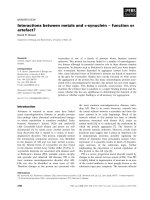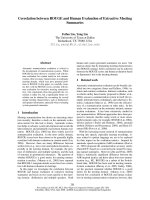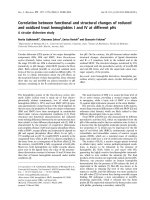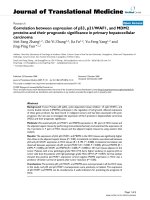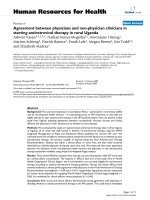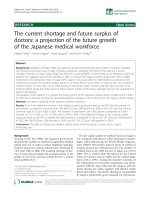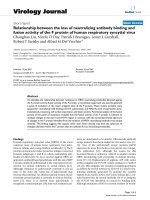Báo cáo sinh học: "Correlation between antibutyrylcholinesterasic and antioxidant activities of three aqueous extracts from Tunisian Rhus pentaphyll" potx
Bạn đang xem bản rút gọn của tài liệu. Xem và tải ngay bản đầy đủ của tài liệu tại đây (335.72 KB, 9 trang )
RESEARCH Open Access
Correlation between antibutyrylcholinesterasic
and antioxidant activities of three aqueous
extracts from Tunisian Rhus pentaphyllum
Hedi Ben Mansour
1*
, Sonia Yatouji
2
, Sihem Mbarek
1
, Ikram Houas
1
, Afef Delai
1
and Dorra Dridi
1
Abstract
For centuries, plants have been used in traditional medicines and there has been recent interest in the
chemopreventive properties of compounds derived from plants. In the present study, we investigated the
antibutyrylcholinest rasic (anti-BuChE) and antioxidant (against some free radicals) activities of extracts from Rhus
pentaphyllum. Aqueous extracts were prepared from powdered R. pentaphyllum roots, leaves and seeds and
characterized for the presence of tannins, flavonoids and coumarins. Seeds aqueous extract contained the highest
quantities of both flavonoids and tannins (21.12% and 17.45% respectively). In the same way, seeds extracts
displayed remarkable inhibition against BuChE over 95%, at 100 μg/ml and with IC
50
0.74 μg/ml. In addition,
compared to leaves and roots extracts, seeds aqueo us extract revealed relatively strong antiradical activity towards
the ABTS
.+
(IC
50
= 0.25 μg/ml) and DPPH (IC
50
= 2.71 μg/ml) free radicals and decreased significantly the reactive
oxygen species such O
2
(IC
50
= 2.9 μg/ml) formation evaluated by the non-enzymatic generating O
2
system
(Nitroblue tetrazolium/riboflavine). These data sug gest that the anti-BuChE activities mechanism of these extracts
occurs through a free radical scavenging capacities.
The present study indicates that extracts of Rhus pentaphyllum leaves, seeds and roots are a significant source of
compounds, such as tannins, flavonoids and coumarins, with anti-BuChE and antioxidant activities, and thus may
be useful for chemoprevention.
Keywords: Rhus pentaphyllum, anti-Butyrylcholinesterasic activity, free radical scavenging activity, antioxidant
activity
Introduction
Alzheimer’s disease (AD) is a degenerative neurological
disorder characterized by senile plaques containing amy-
loid b protein and loss of cholinergic neuromediators in
the brain [1,2]. The most remarkable biochemical
change in AD patients is a reduction of acetylcholine
(ACh) levels in the hippocampus and cortex of the brain
[3]. Therefore, inhibition of acetylcholinesterase (AChE),
the enzyme responsible for hydrolysis of ACh at the
cholinergic synapse, is currently the most established
approach to treating AD [4]. While AChE is found in all
excitable tissue, whether nerve or muscle, in most ery-
throcytes and in placental tissue, BChE is present more
commonly in the body including the central and periph-
eral ne rvous system, liver and plasma [5]. On the other
hand, oxidative stress caused by react ive oxygen sp ecies
(ROS), is known to cause the oxidation of biomolecules
leading to cellular damage. It is also speculated to be
pathologically important in various neurodegenerative
processes including cognitive deficits that occur during
normal cerebral aging, Alzheimer’s disease (AD) and
Parkinson’s disease [6-8]. Nowaday s, the most accepted
theory about the disturb ing effect of free radi cal s in the
process of aging was reported by Harman [9]. Later on,
it was also reported that oxidative stress is associated
with the pathogenesis of AD an d cell ular characteristics
of this disease are either causes or effects of oxidative
stress [10,11].
These evidences clearly show that oxidative stress, an
early event in AD, may play a key pathogenic role in the
* Correspondence:
1
Institut Supérieur de Biotechnologie (ISB), Technopole Sidi Thabet,
Université la Manouba 2020 Ariana Tunisie
Full list of author information is available at the end of the article
Mansour et al. Annals of Clinical Microbiology and Antimicrobials 2011, 10:32
/>© 2011 Mansour et al; licensee BioMed Ce ntral Ltd. This is an Open Access article distributed under the terms of the Creative
Commons Attribution License ( g/licenses/by/2.0), which permits unrestricted use, distribution, and
reproduction in any medium, provi ded the original work is properly cited.
disease [12]. Interestingly, intake of polyphenols through
diets rich in fruits, vegetables and beverages such as red
wine was stated to reduce incidence of certain
age related neurological disorders including macular
degeneration and dementia [6,13]. Therefore, the sup-
plemental consumption of polyphenolic antioxidants
compounds by people could reduce the risk of AD.
Recently, plant extracts have been the subject of a lot
of research in order to obtain compounds able to inhibit
AChE. Most of these studies indicate that plants are a
good source of molecules with this inhibition activity
[14,15]. Most of the compounds isolated from the plant
polar extract fraction are polyphenols [16,17]. These
compounds also have a high antioxidant activity [16,18].
The antioxidant activity found in some compounds has
been connected to t he capacity to scavenge the free
radicals that are formed during the inflammation pro-
cesses [19].
As part of our studies on potential chemopreventive
agen ts, we ha ve evaluated the antibutyrylchol inest erasic,
antiradical, and antioxidant effects of aqueous extracts
from Rhus pentaphyllum collected from Melloulech in
the center of Tunisia.
1. Materials and methods
1.1. Chemicals
1,1-diphenyl-2-picryl-hydrazyl (DPPH), allopurinol, a-
tocopherol, nitroblue- tetrazolium (NBT), 6-hydroxy-
2,5,7,8-tetramethylchroman-2-carboxylic acid (Trolox),
2,2’-azino-bis(3-ethylbenzothiazoline-6-sulfonic acid)
diammonium salt (ABTS
.+
)wereobtainedfromSigma
Co (St. Louis, USA). Butyrylthiocholine iodide and 5,5’-
dithiobis [2-nitrobenzoic acid] (DTNB) were purchased
from Quimica Clinica Aplicada S.A. (Amposta, Spain).
1.2. Plant materials
R. pentaphyllum was collected from station of Mellou-
lech situated in the Center east of Tunisia in December
2008. Botanical identificati on was carried out by Dr.
Amer Aissi (Pharmacognosy laboratory Faculty of Phar-
macy Monastir - Tunisia). A voucher specimen (RP-
10.03) has been deposited in the High Biotechnological
Institute Sidi Thabet, for future reference.
1.3. Extraction Procedure
Three aqueous extracts were prepared from respectively
the powdered leaves, root and seeds by boiling in water
for 1 h. The extracts were filtered and lyophilized, and
the residues were dissolved in water.
1.4. Preliminary phytochemical analysis
The various aqueous extracts were screened for the pre-
sence of tannins and flavonoids by using the methods
previously described by Mansour et al. [20] Two
milligrams of each extract were dissolved in 2 ml of
water. The identification of major chemical groups was
carried out by thin layer chromatography (TLC) on
silica gel 60 F254 Merck (layer thickness, 0.25 mm), as
follows. For flavonoids, the TLC was developed in n-
butanol/acetic acid/water (4:1:5), and the spots were
visualized with 1% aluminiu m chloride in methanol
under UV (366 nm). The test for tannins was carried
out with FeCl
3
. Each class of tannins produced a specific
color.
1.5. Quantitative analysis of extracts
Flavonoids were quantified by using the method
described by Dohou et-al [21]. Twenty milligrams of
each extract were dissolved separately in 2 ml of 80%
methanol and sonicated (30 sec, 100%) with a Sonics
vibra-cell ultrasonic processor (Bioblock Scientific, Ill-
kirch, France). After addition of 100 μl of diphenylbori-
nic acid 2 -aminoethyl ester (1% (w/v) in methanol) to
each solution, the absorbance of flavonoids was deter-
mined spectrophotometrically at 404 nm and compared
to a quercetin standard (0.05 mg/ml). The percentage of
total flavonoids was then calculated in quercetin equiva-
lents according to the following formula:
F=(0.05A
ext
/A
q
) 100/C
ex
t
where Aext and Aq were the absorbance of the extract
and of quercetin, respectively, and C ext was the extract
concentration (10 mg/ml).
Tannins were q uantified according to the method
developed by Porter et al. [22] and adapted by Mansour
et al. [20]. Solutions (1 g/l) of each extract were soni-
cated (30 sec, 100%), distributed in glass tubes, and
sealed with a Teflon-lined screw cap. 2.5 ml of n-buta-
nol-HCl (95:5, v/v) and 100 μl of a 2% (w/v) ferric
reagent (NH
4
Fe (SO
4
)
2
. 12H
2
O) were added to each
tube. The solutions were capped, thoroughly mixed, and
suspended in a constant-level water bath at 95°C for 40
min. The solutions were cooled and the visible spectrum
was determined at 540 nm. The percentage of total con-
densed tannins was then calculated in cyanidol (stan-
dard) equivalents according to the following formula:
T
=[
(
A
540nm
/ ∈ l
)
1/C
ext
]10
0
Where l = 1 cm, Є = 42390 l/mol/cm, and C
ext
is
extract concentration.
1.6. In vitro Butyrylcholinesterase inhibition assay
Human plasma preparation
Human blood from anonymous healthy men subject (27
years) was provided by the Centre d’Assistance Médical
Urgente (C.A.M.U) Hôpital Charles Nicolle in Tunisia.
Blood was collected in EDTA treated (1 mg/ml) glass
Mansour et al. Annals of Clinical Microbiology and Antimicrobials 2011, 10:32
/>Page 2 of 9
tubes, the red blood cells were eliminated by centrifuga-
tion at 2000 g for 10 min, the plasma (supernatant) was
then recuperated and diluted (1/200) with 50 mM phos-
phate buffer (pH = 7.4). Plasma was used immediately
for studying butyrylcholinesterase (BuChE) activity or
conserved at 2-8°C (stable for 7 days).
Butyrylcholinesterase inhibition assay
BuChE inhibi ting activity was measured by the spectro-
photometric method p reviously reported by Ellman et
al. [23], modified by Ortega et al. [24] and adapted
according to our experimental conditions. Butyrylthio-
choline iodide was used as substrate to assay butyrylcho-
linesterase activity. In order to calculate the activity of
the obtained butyrylcholinesterase, the following proce-
dure was employed: 1.5 ml of phosphate buffer 50 mM
pH = 7.2, containing 0.26 mM of 5,5’-dithiobis-2 - nitro-
benzoic acid (DTNB), 10 μl of human plasma and 10 μl
of the tested compound (1, 10 and 100 μg/ml as final
concentrations) were placed in a microcuvette, which
was incubated for 15 min at 30°C. The hydrolysis of
butyrylthiocholine was monitored by the formation of
yellow 5-thio- 2-nitrobenzoate anions resulting from the
reaction of DTNB with the thiocholine released by the
enzymatic hydrolysis of butyrylthiocholine. Absorbance
was measured using an M350 double Beam UV-VIS
spectrophotometer «Camespec» at 405 nm, and the
reading w as repeated during 75 s at intervals of 30 s to
verify the linearity of the reaction. The enzymatic activ-
ity was calculated using the absorption coefficient 23460
and according to the relation:
Enzymatic activity
(
UI/1
)
= 23460 ×
(
DO
405nm
t
0s
− DO
405nm
t
75s
)
The percentage (%) inhibition of BuChE activity was
calculated as follows (E - S)/E × 100, where E is the
activity of the enzyme without test compound (in our
case E = 9 000 UI/l (international unite)) and S is the
activity of enzyme with test compound.
IC
50
(concentrations of test compounds that inhibited
the hydrolysis of substrate (butyrylthiocholine) by 50%)
values were calculated from dose-inhibition curves [25].
All experiments were repeated three times.
1.7. DPPH radical-scavenging activity
The free-radical scavenging capacity of the extracts was
determined with DPPH [26]. Ethano l solutions were
prepared containing 100, 30, 10, 3 and 1 μg/mL of the
extracts and 23.6 μg/ml of DPPH. After incubation for
30 min at ambiant temperature, the absorbance of the
remaining DPPH was determined colorimetrically at 517
nm. Radical scavenging activity was measured as the
decrease in absorbance of the samples versus a DPPH
standard solution [27]. Results were expressed as “per-
centage inhibition"(%) of the DPPH and the mean 50%
inhibiting concentration (IC
50
). % is defined by the for-
mula:
(%)=[(OD
control
− OD
sam
p
le
)/OD
control
] × 100
,
Where OD
control
is the initial absorbance and OD
sample
the value for the test sample after incubation [27]. IC
50
was defined as the concent ration (in μg/ml) of substrate
that causes 50% loss of DPPH activity (color) and it was
calculated by using the Litchfield and Wilcoxon test
[20].
The results are expressed as the mean of data from at
least three independent experiments.
1.8. Radical-scavenging activity on ABTS
.+
An improved ABTS
.+
(2,2’-azino-bi s (3-ethylbenzthiazo-
line-6-sulfonic acid) diammonium salt) radical cation
decolorizati on assay was used [28]. It involves the direct
production of the blue/green ABTS
+.
chromophore
through the reaction between ABTS
.+
and potassium
persulfate. Addit ion of antioxidants to the preformed
radical cation reduces it to ABTS
.+
,toanextentandon
a timescale depending on the antioxidant activity, the
concentration of the antioxidant and the duration of the
reaction [29]. ABTS
.+
was dissolved in water to a 7 mM
concentration. ABTS
+.
was produced by reacting ABTS
.+
stock solution with 2.45 mM potassium persulfate (final
concentration) and allowing the mixture to stand in the
dark at room temperature for 12-16 h before use. The
ABTS
+.
solution was diluted with ethanol to an absor-
bance of 0.7 (± 0.02 ) at 734 n m. In order to measure
the antioxidant activity of extracts, 10 μl of each sample
at various concentrations (0.5, 2.5, 4.5, 7.5 and 9.5 mg/
ml) was added to 990 μl of diluted ABTS
+•
and the
absorbance was recorded every 1 min. After 30 min the
kinetic reaction was stopped. Each concentration was
analyzed in triplicate. The percentage decrease of absor-
bance at 734 nm was calculated for each point and the
antioxidant capacity of the t est compounds was
expressed as p ercent inhibition (%). IC
50
value (concen-
tration required to reduce ABTS
+.
by 50%) was calcu-
lated from regression analysis. Trolox (6-hydroxy-
2,5,7,8-t etramethylc hroman- 2-carboxyli c acid) is used
as a standard in comparison for the determination of
the antioxidant activity of a compound. The results are
also reported as the Trolox equivalent antioxidant capa-
city (TEAC), which is the molar concentration of the
Trolox giving the same percentage decrease of absor-
bance of the ABTS
+.
radical cation as 1 mg/ml of the
antioxidant testing extract, at a specific time point [29].
1.9. Superoxide radical-scavenging activity
The inhibition of NBT reduction by photochemically
generated O
2
was used to determine the superoxide
Mansour et al. Annals of Clinical Microbiology and Antimicrobials 2011, 10:32
/>Page 3 of 9
anion scavenging activity of the extracts [30] . The reac-
tion mixture contained 6.5 mM EDTA, 4 μMriboflavin,
96 μM NBT, and 51.5 mM potassium phosphate buffer
(pH 7.4). Superoxide anions were measured by the
increase in the absorbance at 560 nm after 6 min of illu-
mination at room temperature. The plant extracts and
the reference substance (Quercetin) were assayed at dif-
ferent concentrations with three repetitions. IC
50
values
(concentration required to inhibit NBT reduction by
50%) were calculated from dose-inhibition curves
[31,20].
1.10. Statistical Analysis
Data were expressed as the mean 6 standard deviation
of three independent experiments. The statistical ana-
lyses were performed with SPSS™ software v.10.0 (from
SPSS Inc.). Data were analyzed for statistical significance
using Dunnett’s test.
2. Results
2.1. Phytochemical analysis
The results of our analysis on the lyophilized aqueous
extracts are shown in table 1 and 2. Seeds aqueous
extract contained the highest quantities of both flavo-
noids and tannins (21.12% and 17.45% respectively). The
leaves extract had lower amounts of flavonoids and tan-
nins (12.3% and 10.31%, respectively). Whereas, com-
pared to the other extracts, the roots aqueous extract
contained relatively high quantity of tannins, while fla-
vonoids was not detected in this extract (table 2).
The qualitative phytochemical screening showed that
only seeds extract contained coumarins (table 1).
2.2. In vitro butyrylcholinesterase inhibition effect
Results of h uman plasma BuChE inhibitory activity of
the tested R. pentaphyllum extracts are shown in table
IV. All tested extracts were found to inhibit the BuChE
activity. The inhibition was instantly, as evidenced by
the linearity of the absorbance vs. time traces during the
75 s assay period (r
2
> 0.978).
Results indicated that R. pentaphyllum extracts
decreased significantly the human BuChE activity in a
concentration-dependent manner (table 3).
Seeds and leaves aqueous extract displayed remarkable
inhibition over 50% (95% and 87%, respectively) at 100
μg/ml against BuChE and with IC
50
0.74 and 0.81 μg/
ml. Roots aqueous extract have somewhat lower inhibi-
tory activity with IC
50
value 10.35 μg/ml.
2.3. Antioxidant activities
Oxidative effect of plant extracts cannot be evaluat ed by
only a single method. Therefore, commonly accepted
assa ys, including enzymatic and nonenzymatic methods,
were employed to evaluate oxidative effects of some
medicinal plants. Three different reactive species were
used to evaluate the antioxidant activity of the R. penta-
phyllum extracts; the ABTS
.+
, DPPH and superoxide
radicals.
DPPH radical-scavenging activity
DPPH is a molecule containing a stable free radical. The
presence of antioxid ant substances could be revealed by
thedecreaseoftheintensity the purple color typical of
the free DPPH radical [32]. This simple test can provide
information on the ability of a compound to donate an
electron, the number of electrons a given molecule can
donate, and the mechanism of antioxidant action. The
radical-scavenging activities of the extra cts measured as
decolorizing activity following the trappi ng of the
unpaired electron of DPPH are shown in Table 4.
The seeds and leaves aqueous extracts were very
potent radical scavengers, with a percentage decrease
versus the absorbance of the DPPH standard solution of
90 and 78%, respectively, at a concentration of 100 μg/
ml, and IC
50
values of 2.71 and 2.91 μg/ml. These values
were slightly greater than that of the positive control, 3
μg/ml a-tocopherol. Aqueous extract (100 μg/ml)
obtained from roots have scavenging activity of 70% and
have IC
50
value of 10.10 μg/ml.
Radical-Scavenging activity on ABTS
.+
The free radical scavenging capacity of R. pentaphyllum
extracts was evaluated by ABTS
.+
assay (Table 5). Deco-
lorization of ABTS
.+
reflects the capacity of antioxidant
species to donate electrons or hydrogen atoms to inacti-
vate this radical cation. A potential activity was noted at
different tested concentrations of all extracts studies
(table 3). Tested extracts seem to be more actives than
Table 1 Qualitative phytochemical screening of extracts from Rhus pentaphyllum
Seeds aqueous extract Leaves aqueous extract Roots aqueous extract
Tannins ++ ++ ++++
Flavonoids ++++ ++ -
Anthraquinones - - -
Alkaloids - - -
Coumarins ++ - -
Saponosids - - -
−: not detectable; ++: high quantities, ++++: very high quantities.
Mansour et al. Annals of Clinical Microbiology and Antimicrobials 2011, 10:32
/>Page 4 of 9
Trolox (reference), as IC
50
value obtained with trolox
(0.76) is greater than that obtained with the seeds, and
leaves aqueous ex tracts (0.25, 0.37 mg/ml). Roots aqu-
eous extract have somewhat lower inhibitory activity
with IC
50
value 2.31 mg/ml.
The TEAC of different extracts was also calculated.
The TEAC values reflect the relative ability of hydrogen
or electron-donating antioxidant of a sample to scavenge
the ABTS
.+
radical cation compared with that of Trolox.
The results obtained are summarized in table 5. When
referring to TEAC values, seeds, leaves and roots
extracts were potent antioxidant with TEAC values of
respectivel y 2. 19, 1.54 and 1.32 mM, which largely
exceed 1 mM, the TEAC value of positive control
(Trolox).
Effects on superoxide anion generating systems
The superoxide radical (O
2
) is a hig hly toxic species
that is generat ed by numerous biological and photoche-
mical reactions. Via the Haber-Weiss reaction, it can
generate the hydroxyl radical, which reacts with DNA
bases, amino acids, proteins, and polyunsaturated fatty
acids, and produces toxic effects. The toxicity of the
superoxide radical also could be due to the perhydroxyl
intermediate (HO
2
) that reacts with pol yunsaturated
fatty acids. Finally, superoxide may react with NO to
generate peroxynitrite, which is known to be toxic
towards DNA, lipids, and protein s. The NBT assay is
based on the capacity of the extracts to inhibit the
photochemical reduction of nitroblue tetrazolium (N BT)
in the presence of riboflavin. Under these conditions,
NBT can be unevenly reduced in the presence of the O
2
radical to a tetrazoinyl radical that can dismute to the
formazan. In the presence of an antioxidant that can
donate an electron to NBT, the purple color typical of
the formazan decays, a change that can be followed
spectrophotometrically at 560 nm. Results indicated that
R. pentaphyllum extracts decreased significantly the
NBT/riboflavin-generated superoxide radical in a con-
centration-dependent manner. Seeds aqueous extract
seems to be more potent antioxidant with activity per-
centage of 79% at the highest concentration (10 mg/ml)
compared to the other test extracts and an IC
50
of 2.9
mg/ml. The seeds aqueous extract was more active than
the positive control, quercetin, in the assay (Figure 1).
The leaves and ro ots extracts had somewhat lower inhi-
bitory activity with IC
50
values of respectively 4.9 and
9.85 mg/ml.
3. Discussion
Principal role of cholinesterase (ChE) is the termination
of nerve impulse transmission at the cholinergic
synapses by rapid hydrolysis of acetylcholine (ACh).
Table 2 Quantitative Phytochemical Screening (%) of extracts from Rhus pentaphyllum
Seed aqueous extract Leaves aqueous extract Roots aqueous extract
Tannins 17.45* 10.31 35.51**
Flavonoids 21.12** 12.3** 0
Significant difference obtained with: *P < 0.05: **P < 0.01
The reported comparisons concern the contents of extracts in the flavonoids and tannins.
Table 3 Percentage of inhibitions of butyrylcholinesterase activity by the three aqueous extracts from Rhus
pentaphyllum
Tested compounds Concentration (μg/ml) Inhibition (%) against BuChE IC
50
(μg/ml)
Seeds aqueous extract 1 57.11 ± 2.00* 0.74
10 80.34 ± 2.25**
100 94.93 ± 2.00**
Leaves aqueous extract 1 54.78 ± 1.25* 0.81
10 76.30 ± 1.50*
100 87.11 ± 5.50*
Roots aqueous extract 1 32.25 ± 2.35 10.35
10 49.01 ± 3.25
100 67.81 ± 3.67*
(a)
Galanthamine 1 44.5 ± 1.00 7.9
10 59.44 ± 2.5*
100 67.5 ± 2.5*
Significant difference obtained with: *P < 0.05: **P < 0.01
The reported comparisons concern: Seeds aqueous extract versus control
(a)
, leaves aqueous extract versus control
(a)
and roots aqueous extract versus control
(a)
.
Every concentration is compared with its equivalent in the other extract.
Mansour et al. Annals of Clinical Microbiology and Antimicrobials 2011, 10:32
/>Page 5 of 9
Inhibition of ChE serves as a strategy for the treatment
of Alzheimer’s disease (AD), senile dementia, ataxia,
myasthenia gravis and Parkinson’s d isease [33,34] A
var iety of plants has been reported to show ChE inhibi-
tory activit y and so may be relevant to the treatment of
neurodegenerative disorders such as AD [15].
In this study, aqueous extracts prepared from leaves,
seedsandrootsfromR. pentaphyllum were tested to
determine their ability as human BuChE inhibitors. The
BuChE inhibition was determi ned using an adaptation
of the method described by Ellman, et al. [23].
All extracts exhibited moderate to good anti BuChE
activity, in fact, the inhibition capacity shows the following
order: seeds extract > leaves extract > roots extracts. The
best inhibitory activity was exhibited by the seeds extract.
On the other hand, the role of oxidative stress in the
pathogenesis of diseases such as macular degeneration,
certain types of cancer, and Alzheimer’sdisease(AD)
has received substantial attention. For that reason, we
also aimed to look into antioxidant capacities of R. pen-
taphyllum extracts.
Three different reactive species were used to evaluate
the antioxidant activity of the R. pentaphyllum extracts:
the DPPH
.
,ABTS
.+
and O
2
radicals. The superoxide
anio n and other ROS contribute to oxidative stress, and
are known contributors to genetic damage, as well as
degenerative diseases such as cancer [35], Parkinson dis-
ease, and heart ischemia [36]. S ince, the DPPH
.
And the
ABTS
.+
radicals are not biologically relevant, the DPPH
and ABTS
.+
assays were performed as a preliminary
study to estimate the di rect free-radical scavenging abil-
ities of the test extracts. The activity of extracts against
the superoxide radical via the non enzymatic NBT/ribo-
flavin assay system has more relevanc e to p hysiologic al
conditions. Results show that, compared to leaves and
roots e xtracts, seeds aqueous extract revealed relatively
strong antiradical activity towards the ABTS
.+
and
DPPH free radicals and decreased significantly the O
2
formation. Thus, we can suggest that the anti-BuChE
activities occurs through free radical scavenging
capacities.
The antioxidant and anti-BuChE possibilities of R.
pentaphyllum extracts are supported by the detection of
flavonoids and phenolic compounds. In fact, several fla-
vonoids and other phenolic compounds are considered
antioxidants [37,20] and inhibition capacities of BuChE
activity [38,15].
It has been reported, oxidative stress, caused by reac-
tive oxygen species (ROS), is known to cause the oxida-
tion of biomolecules leading to cellular damage. It is
also speculated to be pathologically important in various
neurodegenerative processes includ ing cognitive defici ts
that occur during normal c erebral aging, Alzheimer’s
(AD), and Parkinson’sdiseases[39,40].Nowadays,the
most accepte d theory about the disturbing effect of f ree
radicals in the process of aging was reported by Harman
[41]. Later on, it was also repo rted that oxidative stress
is associated with the pathogenesis of AD and cellular
characteristics of this disease are either causes or effects
of oxidative stress [42,43]. These evidences clearly show
that oxidative stress, an early event in AD, may play a
keypathogenicroleinthedisease[44].Thus,wecan
establish a correlation between the antioxidant and anti-
BuChE capacities and quantity of these phenolic compo-
nents. Curiously , the roots aqueous extract contained a
high quantity of tannins but it exhibited lowest both
antioxidant and anti-BuChE activities than the two
other extracts. We cannot, however, exclude the possibi-
lity that other compounds, particularly coumarins in the
case of seeds aqueous extract, with decreased the
BuChE and free radical properties [45]. On the other
hand, it is not necessarily always to be only one com-
pound that is responsible for these effects, which may as
well be depend on several compounds that act in a
synergistic manner or on compounds which regulate
one another.
Table 4 DPPH free-radical scavenging activity of extracts
from Rhus pentaphyllum
Extracts Concentration
(μg/ml)
%
Inhibition
IC
50
(μg/ml)
Seeds aqueous extract 1 44.34 ± 2.30* 2.71
3 53.45 ± 1.02*
10 66.90 ± 1.10*
30 80.51 ± 2.80**
100 92.12 ± 2.11**
Leaves aqueous extract 1 39.45 ± 0.91 2.91
3 50.45 ± 0.75*
10 64.31 ± 1.50*
30 79.50 ± 2.80*
100 88.11 ± 2.55**
Roots aqueous extract 1 12.12 ± 0.80 10.10
3 34.51 ± 1.35
10 49.51 ± 2.10
30 63.67 ± 1.12*
100 70.11 ± 3.11*
(a)
a-Tocopherol
(positive control)
1 30 ± 2.1 3
3 50 ± 1.3
10 97.3 ± 1.8**
30 98 ± 1.3**
100 98.7 ± 2.2**
Significant difference obtained with: *P < 0.05: **P < 0.01,
The reported comparisons concern: Seeds aqueous extract versus roots
aqueous extract, leaves aqueous extract versus roots aqueous extract and
control
(a)
versus roots aqueous extract. Every concentration is compared with
its equivalent in the other extract.
Mansour et al. Annals of Clinical Microbiology and Antimicrobials 2011, 10:32
/>Page 6 of 9
Table 5 Concentration-dependent ABTS
.+
free radical scavenging activity of Rhus pentaphyllum aqueous extracts and
standard antioxidant Trolox
Extracts Concentration (mg/ml) Inhibition (%) TEAC (mM) IC
50
(mg/ml)
Seeds aqueous extract 0.5 76.4 ± 3.50* 2.19 0.25
2.5 86.12 ± 4.25**
4.5 98.77 ± 6.50**
7.5 100 ± 1.00***
9.5 100 ± 1.50***
Leaves aqueous extract 0.5 61.7 ± 3.50* 1.54 0.37
2.5 87.8 ± 4.40**
4.5 89 ± 1.00**
7.5 98 ± 0.50**
9.5 100 ± 2.50***
Roots aqueous extract 0.5 44.1 ± 0.35 1.32 2.31
2.5 54 ± 1.10*
4.5 67.13 ± 3.10*
7.5 78.61 ± 5.10*
9.5 86.50 ± 2.35**
(a)
Trolox 0.5 22.07 ± 0.25 - 0.76
0.625 32.21 ± 0.50
0.833 53.84 ± 1.50
1.25 65 ± 2.50
2.5 96.85 ± 2.80**
TEAC: Trolox equivalent antioxidant capacity
Significant difference obtained with: *P < 0.05; **P < 0.01; ***P < 0.001
The reported comparisons concern: Seeds aqueous extract versus roots aqueous extract, leaves aqueous extract versus roots aqueous extract and control
(a)
versus roots aqueous extract. Every concentration is compared with its equivalent in the other extract.
0
20
40
60
80
100
024681012
Concentration (mg/ml)
percentage of inhibition of O 2
.
-
Seeds aqueous extract
Roots aqueous extract
Leaves aqueous extract
Quercetin
Figure 1 Scavenging effects of aqueous extracts of R. pentaphyllum against photochemically generated superoxide free radicals (O
2
).
Mansour et al. Annals of Clinical Microbiology and Antimicrobials 2011, 10:32
/>Page 7 of 9
In summary, R. pentaphyllum extracts appear to con-
tain compounds with antioxidant and chemoprotective
properties. Therefore, these data suggest that high diet-
ary or suppleme ntal consumption o f antioxidants in
people may reduce the risk of AD. However, further stu-
dies are required to fractionate the active extracts, to
identify the active compo unds, and t o determine their
exact mechanism of action.
Author details
1
Institut Supérieur de Biotechnologie (ISB), Technopole Sidi Thabet,
Université la Manouba 2020 Ariana Tunisie.
2
Unité 05/UR/09-09, Mécanismes
Moléculaires et Pathologies, Faculté de Médecine de Monastir, 5019
Monastir, Tunisie.
Authors’ contributions
HBM is the primary author of the manuscript, planed the work, assisted in
extracts preparation from powdered R. pentaphyllum roots, leaves and seeds
and their chemical characterized. SY contributed in the
antibutyrylcholinestrasic activity of all extracts. SM helped in the antioxidant
activity against 1,1-diphenyl-2-picryl-hydrazyl (DPPH). AD participated in the
antioxidant activity against 2,2’-azino-bis(3-ethylbenzothiazoline-6-sulfonic
acid) diammonium salt (ABTS
.+
). IH participated in the antioxidant activity
against superoxidae anion used by the non-enzymatic system nitroblue-
tetrazolium (NBT). DD contributed in the statistical analyzes of data.
All the authors read and approved the final version of the manuscript.
Competing interests
The authors declare that they have no competing interests.
Received: 18 June 2011 Accepted: 31 August 2011
Published: 31 August 2011
References
1. Lawrence AD, Sahakian BJ: The cognitive psychopharmacology of
Alzheimer’s disease: Focus on cholinergic systems. Neurochem Res 1998, ,
23: 787-794.
2. Whitehouse PJ, Price DL, Struble RG, Clark AW, Coyle JT, Delon MR:
Alzheimer’s disease and senile dementia: Loss of neurons in the basal
forebrain. Science 1982, , 215: 1237-1239.
3. Jaen JC, Gregor VE, Lee C, Davis R, Emmerling M: Acetylcholinesterase
inhibition by fused dihydroquinazoline compounds. Bioorganic Med Chem
Lett 1996, , 6: 737-742.
4. Schneider LS: New therapeutic approaches to Alzheimer’s disease. J Clin
Psychiatry 1996, 57:30-36.
5. Massoulie J, Pezzementi L, Bon S, Krejci E, Vallette FM: Molecular and
cellular biology of cholinesterases. Prog Neurobiol 1993, , 41: 31-91.
6. Bastianetto S, Quirion R: Natural extracts as possible protective agents of
brain aging. Neurobiol Aging 2002, , 23: 891-897.
7. Behl C, Moosmann B: Antioxidant neuroprotection in Alzheimer’sdiseaseas
preventive and therapeutic approach. Free Rad Biol Med 2002, , 33: 182-191.
8. Gray SL, Hanlon JT, Landerman LR, Artz M, Schmader KE, Fillenbaum GG: Is
antioxidant use protective of cognitive function in the community-
dwelling elderly. Am J Geriatric Pharm 2003, 1:3-8.
9. Harman D: Aging: a theory based on free radical and radiation
chemistry. J Gerontol 1956, 11:298-300.
10. Smith MA, Harris PL, Sayre LM, Perry G: Iron accumulation in Alzheimer
disease is source of redox-generated free radicals. Proc Nat Acad Sc 1997,
94:9866-9868.
11. Vina J, Lloret A, Orti R, Alonso D: Molecular bases of the treatment of
Alzheimer’s disease with antioxidants: Prevention of oxidative stress.
Mol. Aspect. Med 2004, , 25: 117-123.
12. Zhu X, Raina AK, Lee HG, Casadesus G, Smith MA, Perry G: Oxidative stress
signaling in Alzheimer’s disease. Brain Res 2004, , 10: 32-39.
13. Commenges D, Scotet V, Renaud S, Jacqmin-Gadda H, Barberger-Gateau P,
Dartigues JF: Intake of flavonoids and risk of dementia. Eur J Epidemiol
2000, , 16: 357-363.
14.
Ingkaninan K, Temkitthawon P, Chuenchom K, Yuyaem T, Thongnoi W:
Screening for acetylcholinesterase inhibitory activity in plants used in
Thai traditional rejuvenating and neurotonic remedies. J Ethnopharmacol
2003, , 89: 261-264.
15. Mukjerjee PK, Kumar V, Mal M, Houghton PJ: Acetylcholinesterase
inhibitors from plants. Phytomed 2007, , 14: 289-300.
16. Cai Y, Luo Q, Sun M, Corke H: Antioxidant activity and phenolic
compounds of 112 traditional Chinese medicinal plants associated with
anticancer. Life Sc 2004, , 74: 2157-2184.
17. Trouillas P, Calliste CA, Allais DP, Simon A, Marfak A, Delage C, Duroux JL:
Antioxidant, anti-inflammatory and antiproliferative properties of sixteen
water plant extracts used in Limousin countryside as herbal teas. Food
Chem 2003, , 80: 399-407.
18. Djeridane A, Yousfi M, Nadjemi B, Boutassouna D, Stocker P, Vidal N:
Antioxidant activity of some Algerian medicinal plants extracts
containing phenolic compounds. Food Chem 2006, , 97: 654-660.
19. Gomes A, Fernandes E, Lima JLFC, Mira L, Corvo ML: Molecular
mechanisms of anti-inflammatory activity mediated flavonoids. Curr Med
Chem 2008, , 15: 1586-1605.
20. Mansour HB, Boubaker J, Bouhlel I, Mahmoud A, Bernillon S: Antigenotoxic
Activities of Crude Extracts From Acacia salicina Leaves. Environ Mol Mut
2007, , 48: 58-66.
21. Dohou N, Yamni K, Tahrouch S, Hassani Idrissi LM, Badoc A, Gmira N:
Screening phytochimique d’une ende’mique ibe’ro-Marocaine,
Thymelaea lythoroides. Bull Soc Pharm Bordeaux 2003, 142:61-78.
22. Porter LJ, Hrstich LN, Chan BG: The conversion of procyanidins and
prodelphinidins to cyanidin and delphinidin. Phytochemistry 1986, , 25:
223-230.
23. Ellman GL, Courtney KD, Andres VJR, Feather-Stone RM: A new and rapid
colorimetric determination of acetylcholinesterase activity. Biochem
Pharmacol 1961, , 7: 88-95.
24. Ortega MG, Agnese AM, Cabrera JL: Anticholinesterase activity in an
alkaloid extract of Huperzia saururus. Phytomed 2004, , 11: 539-543.
25. Noor A-T, Fatima I, Ahmad I, Malik A, Afza N, Iqbal L, Latif M, Khan SB:
Leufolins A and B, Potent Butyrylcholinesterase-inhibiting Flavonoid
Glucosides from Leucas urticifolia. Molecules 2007, 12:1447-1454.
26. Gülçin I: Antioxid ant properties of resveratrol: A structure-activity
insight. Innovative. Food Science and Emerging Technologies
2010,
11:210
-218.
27. Yagi A, Kabash A, Okamura N, Hararguchi H, Moustafa SM, Khalifa TI:
Antioxidant, free radical scavenging and anti-inflammatory effects of
aloesin derivatives in Aloe vera. Planta Med 2002, 68:957-960.
28. Talaz O, Gülçin I, Göksu S, Saracoglu N: Antioxidant activity of 5,10-
dihydroindeno[1,2-b]indoles containing substituents on dihydroindeno
part. Bioorganic and Medicinal Chemistry 2009, 17:6583-6589.
29. Lee SE, Shin HT, Hwang HJ, Kim JH: Antioxidant activity of extracts from
Alpinia katsumadai seed. Phytother Res 2003, 17:1041-1047.
30. Gülçin I: Antioxidant activity of L-Adrenaline: An activity-structure insight.
Chemico-Biological Interaction; 2009:179:71-80.
31. Re R, Pellegrini N, Proteggente A, Pannala A, Yang M, Rice-Evans C:
Antioxidant activity applying an improved ABTS
.+
radical cation
decolorization assay. Free Radical Bio Med 1999, 26:1231-1237.
32. Gülçin I, Elias R, Gepdiremen A, Taoubi K, Köksal E: Antioxidant secoiridoids
from fringe tree (Chionanthus virginicus L.). Wood Sciences and
Technology 2009, 43:195-212.
33. Sokmen M, Angelova M, Krumova E, Pashova S, Ivancheva S, Sokmen A,
Serkedjieva A: In vitro antioxidant activity of polyphenol extracts with
antiviral properties from Geranium sanguineum L. Life Sci 2005,
76:2981-2993.
34. Atta-ur-Rahman , Choudhary M: Bioactive natural products as a potential
source of new pharmacophores a theory of memory. Pure Appl Chem
2001, , 73: 555-560.
35. Sander CS, Chang H, Hamm F, Elsner P, Thiele JJ: Role of oxidative stress
and the antioxidant network in cutaneous carcinogenesis. Int J Dermatol
2004, , 43: 326-335.
36. Gonzalez-Avila M, Arriaga-Alba M, La-Garza MD, HermandezPreteline MDC,
Dominguez-Ortiz MA, Fattel-Fazenda S, Villa-Trevino S: Antigenotoxic,
antimutagenic and ROS scavenging activities of a Rhoeo discolor
ethanolic crude extract. Toxicol In Vitro 2003, 17:77-83.
37. Cos P, Ying L, Calomme M, Hu JP, Cimanga K, Van Poel B, Potier L,
Vlientink AJ, Vanden Berghe D: Structure-activity relationship and
Mansour et al. Annals of Clinical Microbiology and Antimicrobials 2011, 10:32
/>Page 8 of 9
classification of flavonoids as inhibitors of xanthine oxidase and
superoxide scavengers. J Nat Prod 1998, , 61: 71-76.
38. Orhan I, Kartal M, Naz Q, Ejaz A, Yilmaz G, Kan Y, Konuklugil B, Bilge SM,
Choudhary I: Antioxidant and anticholinesterase evaluation of selected
Turkish Salvia species. Food Chem 2007, , 103: 1247-1254.
39. Bastianetto S, Quirion R: Natural extracts as possible protective agents of
brain aging. Neurobiology of Aging 2002, 23:891-897.
40. Behl C, Moosman B: Antioxidant neuroprotection in Alzheimer’s disease
as preventive and therapeutic approach. Free Radical Biology and Medicine
2002, 33:182-191.
41. Harman D: Aging: a theory based on free radical and radiation
chemistry. Journal of Gerontology 1956, 11:298-300.
42. Smith MA, Harris PL, Sayre LM, Perry G: Iron accumulation in Alzheimer
disease is source of redox-generated free radicals. Proceedings of National
Academy of Sciences of USA 1997, 88:10540-10543.
43. Smith MA, Perry G, Richey PL, Sayre LM, Anderson VE, Beal MF: Oxidative
damage in Alzheimer’s disease. Nature 1996, 382:120-121.
44. Zhu X, Raina AK, Lee HG, Casadesus G, Smith MA, Perry G: Oxidative stress
signaling in Alzheimer’s disease. Brain Research 2004, 1000:32-39.
45. Fallarero A, Oinonen P, Gupta S, Blom P, Galkin A, Mohan CG, Vuorela PM:
Inhibition of acetylcholinesterase by coumarins: The case of coumarin
106. Pharmacol Res 2008, , 58: 215-221.
doi:10.1186/1476-0711-10-32
Cite this article as: Mansour et al.: Correlation between
antibutyrylcholinesterasic and antioxidant activities of three aqueous
extracts from Tunisian Rhus pentaphyllum. Annals of Clinical Microbiology
and Antimicrobials 2011 10:32.
Submit your next manuscript to BioMed Central
and take full advantage of:
• Convenient online submission
• Thorough peer review
• No space constraints or color figure charges
• Immediate publication on acceptance
• Inclusion in PubMed, CAS, Scopus and Google Scholar
• Research which is freely available for redistribution
Submit your manuscript at
www.biomedcentral.com/submit
Mansour et al. Annals of Clinical Microbiology and Antimicrobials 2011, 10:32
/>Page 9 of 9
